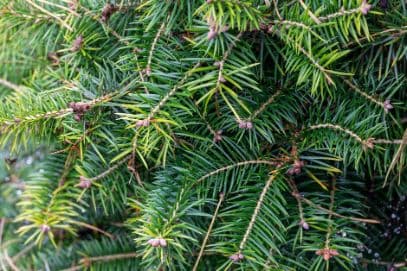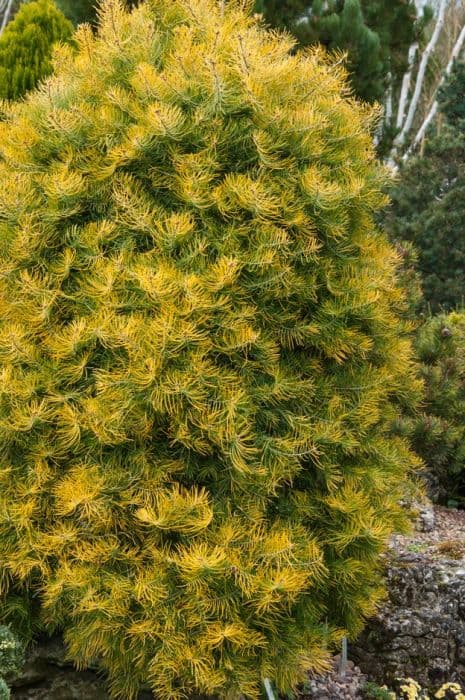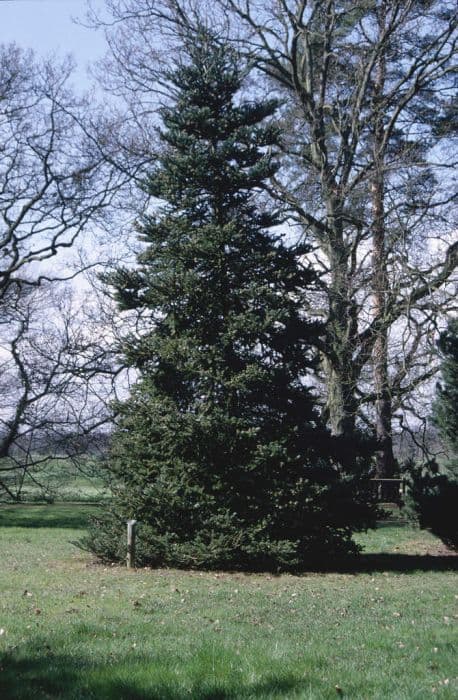Golden Oriental Spruce Picea orientalis 'Aurea' (v)

ABOUT
The plant known as the Golden Oriental Spruce is a stunning conifer that captures attention with its unique color and texture. This evergreen is notable for its shimmering golden needles that impart a luminous quality, especially when the sunlight beckons upon them. The needles themselves are somewhat short, creating a dense and full appearance. With age, the tree's foliage deepens to a gleaming, almost metallic gold, which is most intense at the tips of the new growth, resulting in a magnificent contrast against the darker green mature needles. The Golden Oriental Spruce typically sports a pyramidal shape, featuring a central leader from which branches radiate outward and slightly droop, giving the tree a graceful, soft silhouette. The branches are arranged in a neat, orderly fashion, contributing to the plant's well-groomed look. In the spring, the tree may exhibit tiny cones that begin as a striking purple color and mature into a subtler brown, adding to the plant's ornamental charm. Its bark, although not as prominently displayed as its foliage, possesses a rugged texture that provides a pleasing background to the radiant needles. Overall, the Golden Oriental Spruce exudes a sense of elegance and provides year-round interest to any garden with its vibrant, ever-changing hues.
About this plant
 Names
NamesFamily
Pinaceae
Synonyms
Golden Oriental Spruce, Aurea Oriental Spruce, Oriental Spruce 'Aurea'
Common names
Picea orientalis 'Aureospicata', Picea orientalis 'Aurea Nana', Picea orientalis 'Golden'
 Toxicity
ToxicityTo humans
Oriental spruce is not known to be toxic to humans. There are no common reports of poisoning or adverse reactions from ingesting or handling this plant. However, as with many plants, individual allergies or sensitivities could cause mild irritation, so it is generally advisable not to ingest plant material that is not meant for consumption.
To pets
Oriental spruce is not considered toxic to pets. It should not cause any serious symptoms of poisoning if ingested by animals such as cats and dogs. As with any non-food plant, ingestion of large amounts could potentially cause mild gastrointestinal upset due to the indigestible nature of the plant material.
 Characteristics
CharacteristicsLife cycle
Perennials
Foliage type
Evergreen
Color of leaves
Yellow-green
Height
40 feet 12 meters [12m]
Spread
10 feet 3 meters [3m]
Plant type
Tree
Hardiness zones
4
Native area
Caucasus
Benefits
 General Benefits
General Benefits- Ornamental Value: The Picea orientalis 'Aurea', often known as the Golden Oriental Spruce, has visually striking golden-yellow foliage that adds a splash of color to any landscape.
- Habitat Support: Provides shelter and nesting sites for birds and other wildlife due to its evergreen nature and dense branches.
- Shade and Cooling: Its conical shape and evergreen foliage offer shade during the warmer months, contributing to cooling effects in gardens and landscapes.
- Windbreak: When planted in rows or groups, it can act as a windbreak, offering protection against strong winds and reducing soil erosion.
- Privacy Screen: The dense foliage can serve as a natural privacy screen all year round, which can be beneficial in urban or suburban settings.
- Seasonal Interest: The Golden Oriental Spruce retains its ornamental value throughout the year, including during the winter months when other plants may lose their leaves.
- Adaptability: It is adaptable to a variety of soil types, provided they are well-drained, making it a versatile choice for different landscape conditions.
 Medical Properties
Medical PropertiesThis plant is not used for medical purposes.
 Air-purifying Qualities
Air-purifying QualitiesThis plant is not specifically known for air purifying qualities.
 Other Uses
Other Uses- Oriental Spruce 'Aurea' can be utilized as a natural sound barrier due to its dense foliage, effectively reducing noise pollution when planted in groups along roads or between properties.
- The wood of Oriental Spruce 'Aurea' is sometimes used in the construction of musical instruments such as violins and pianos for its resonant qualities.
- Due to its slow growth and small needles, it is often used in bonsai cultivation, offering a creative outlet and a way to practice the art of bonsai shaping.
- This plant's unique golden-yellow foliage can be used as a natural dye, providing a range of yellow hues for textiles or crafts.
- Oriental Spruce 'Aurea' is utilized in landscaping to create focal points because of its distinct color, especially in winter gardens where color is sparse.
- The tree can act as a windbreak in colder climates, protecting smaller plants and reducing wind speed on properties.
- Incorporating Oriental Spruce 'Aurea' in urban environments can help to increase biodiversity by providing habitat and food for various bird species.
- Its dense form and evergreen nature make it an excellent option for creating privacy hedges and screens in residential gardens.
- The tree is also popular for themed gardens, such as gold or yellow gardens, where its foliage contributes to the color scheme.
- During the holidays, the Oriental Spruce 'Aurea' is sometimes used as a living Christmas tree that can be decorated outdoors and enjoyed for its seasonal color and festive appearance.
Interesting Facts
 Feng Shui
Feng ShuiThe Oriental spruce is not used in Feng Shui practice.
 Zodiac Sign Compitability
Zodiac Sign CompitabilityThe Oriental spruce is not used in astrology practice.
 Plant Symbolism
Plant Symbolism- Growth: As a variety of spruce tree, the Picea orientalis 'Aurea', commonly known as the Oriental Spruce, represents growth and expansion, mirroring the tree's natural inclination to reach upwards and outwards.
- Resilience: The Oriental Spruce's ability to withstand cold climates and grow in various conditions is emblematic of resilience and the capacity to endure challenging situations.
- Longevity: Trees are often associated with a long lifespan, and Oriental Spruce is no exception. It symbolizes endurance over time and the passage of generations.
- Peace: The evergreen nature of the Oriental Spruce, remaining vibrant throughout seasons, is often seen as a symbol of peace and tranquility.
- Protection: In folklore, spruce trees were thought to offer protection against evil and harm because of their sturdy and robust nature.
 Water
WaterThe Oriental Spruce 'Aurea' should be watered deeply and thoroughly, ensuring the soil is moist but not waterlogged. During the active growth season in spring and summer, water approximately once a week with about 1 to 2 gallons depending on the size of the tree and weather conditions. In fall, reduce watering to every two weeks, and in winter, water only if there's a dry spell with less than an inch of precipitation in a month. It's crucial to adjust water based on rainfall, as overwatering can lead to root rot.
 Light
LightThe Oriental Spruce 'Aurea' thrives best in full sun to part shade. It should be planted in a spot where it can receive at least 4 to 6 hours of direct sunlight daily. Adequate light is essential for the plant to develop its characteristic golden-yellow foliage color. However, in extremely hot climates, some afternoon shade can be beneficial to prevent scorching.
 Temperature
TemperatureThe Oriental Spruce 'Aurea' is a hardy plant that can tolerate a wide temperature range. It can withstand minimum winter temperatures down to -30°F and is suited for USDA hardiness zones 4 through 7. The ideal temperature for robust growth is between 60°F and 70°F during the growing season. Extreme heat above 90°F can be detrimental, particularly if combined with drought conditions.
 Pruning
PruningPruning of the Oriental Spruce 'Aurea' is often done to maintain shape or to remove any dead or diseased branches. The best time to prune is in late winter or early spring before new growth starts. Pruning can be performed annually, but this tree generally requires minimal pruning unless for shaping purposes or to encourage more dense growth.
 Cleaning
CleaningAs needed
 Soil
SoilThe Golden Oriental Spruce requires a well-draining soil mix with a slightly acidic to neutral pH, typically between 5.5 and 7. A good mix would be one part peat, one part pine bark, and one part perlite or sand. This ensures good drainage and mimics its natural growing conditions.
 Repotting
RepottingGolden Oriental Spruce trees in landscapes usually do not require repotting as they are planted in the ground. For container-grown trees, repot every 3 to 5 years to refresh the soil and allow for root growth.
 Humidity & Misting
Humidity & MistingGolden Oriental Spruce prefers outdoor conditions where it can get natural ambient humidity. It typically thrives in moderate humidity and does not require specific humidity adjustments when grown in its preferred outdoor environment.
 Suitable locations
Suitable locationsIndoor
Provide bright light, cool temps, and ensure pot has drainage.
Outdoor
Plant in sunny spot, ensure soil drains well, mulch root zone.
Hardiness zone
4-7 USDA
 Life cycle
Life cycleOriental Spruce 'Aurea' (Picea orientalis 'Aurea') begins its life cycle when a fertilized seed germinates in suitable soil conditions. The seedling emerges from the seed coat and starts to develop a root system and shoot. As the plant matures, it enters a phase of rapid growth where it will develop its characteristic conical shape and evergreen needles, which are initially golden-yellow before turning green. During its reproductive stage, the Oriental Spruce produces cones; the female cones are larger and contain seeds, while the smaller male cones release pollen. The mature tree reaches reproductive maturity and can produce seeds annually, continuing the cycle if conditions are favorable. The Oriental Spruce 'Aurea' can live for many years, often surpassing a century, and throughout its life span will experience cycles of growth, reproduction, and eventual senescence.
 Propogation
PropogationPropogation time
Late winter-early spring
Propogation: The Golden Oriental Spruce, scientifically known as Picea orientalis 'Aurea' (v), is often propagated through the method of grafting. This is typically carried out during the dormant season, which generally falls in late winter to early spring. In grafting, a piece of the parent plant, known as a scion, which contains the desired genetic material, is attached to a rootstock of another plant. The scion is usually 2-6 inches long, and the diameter should match that of the rootstock. Both the scion and the rootstock are cut at matching angles and then joined together. They are held in place with grafting tape or a similar material to keep them secure until the graft heals and the tissues fuse, usually over a period of several weeks to months. This method is favored because it ensures the resulting plant will retain the ornamental qualities of the Golden Oriental Spruce, including its unique golden needle coloration.









